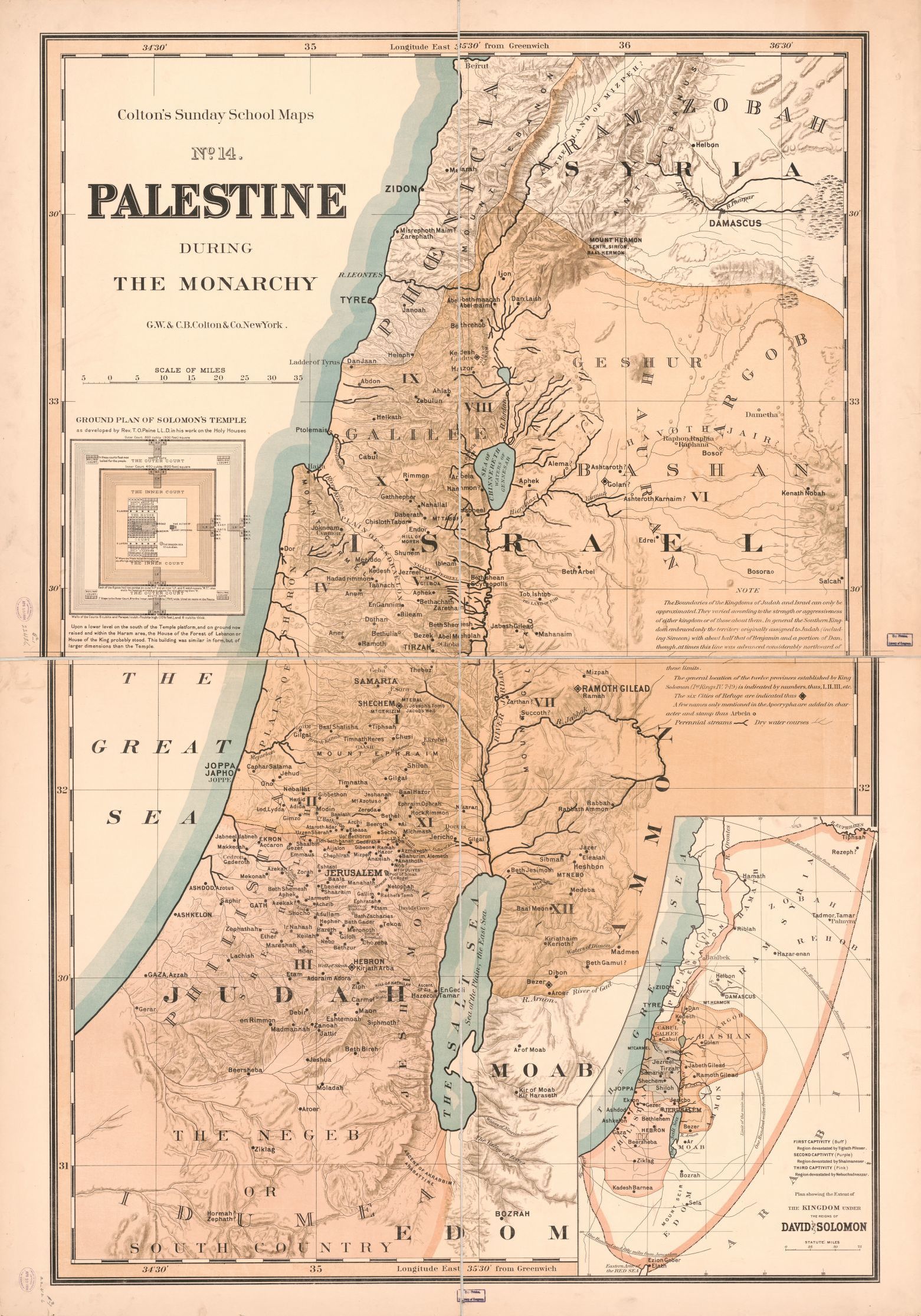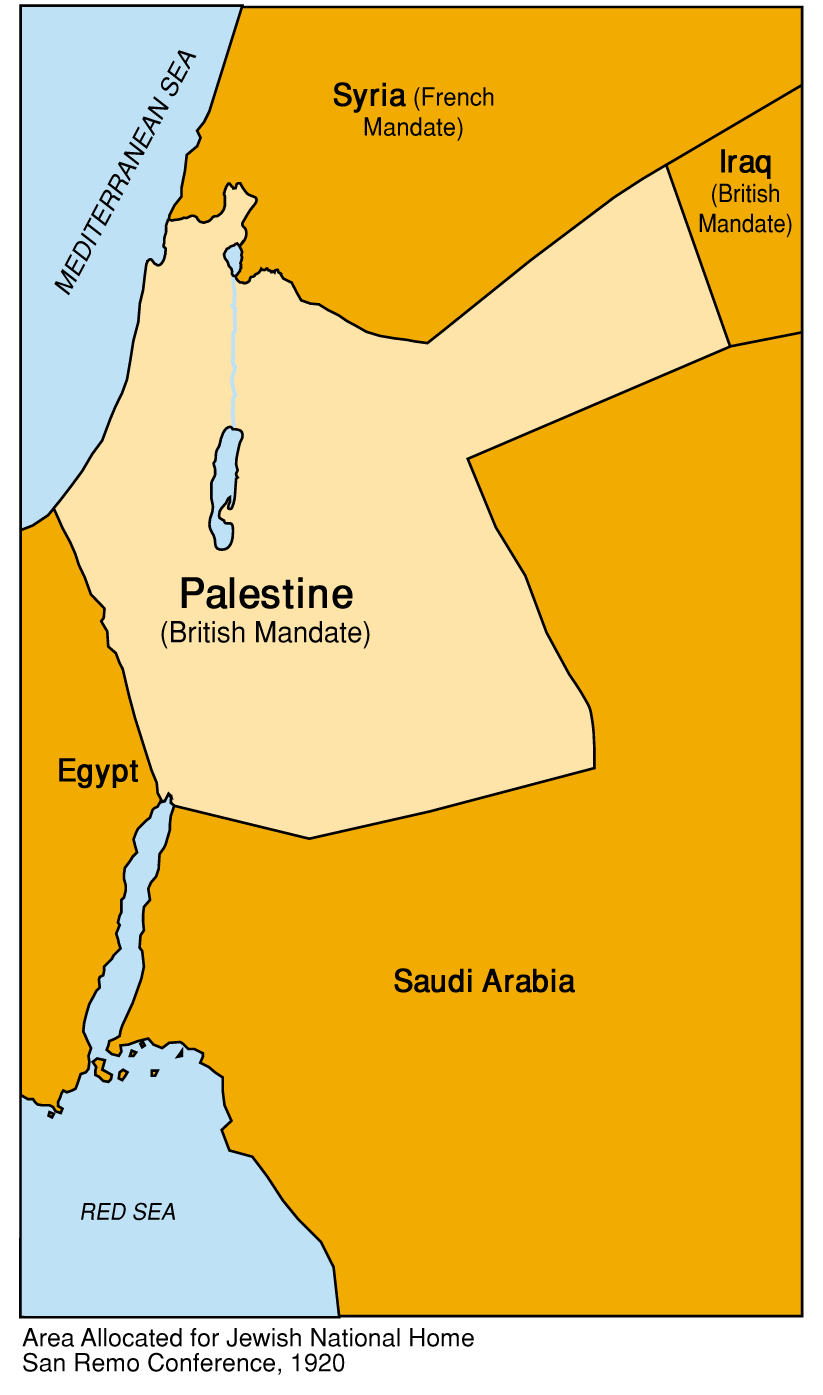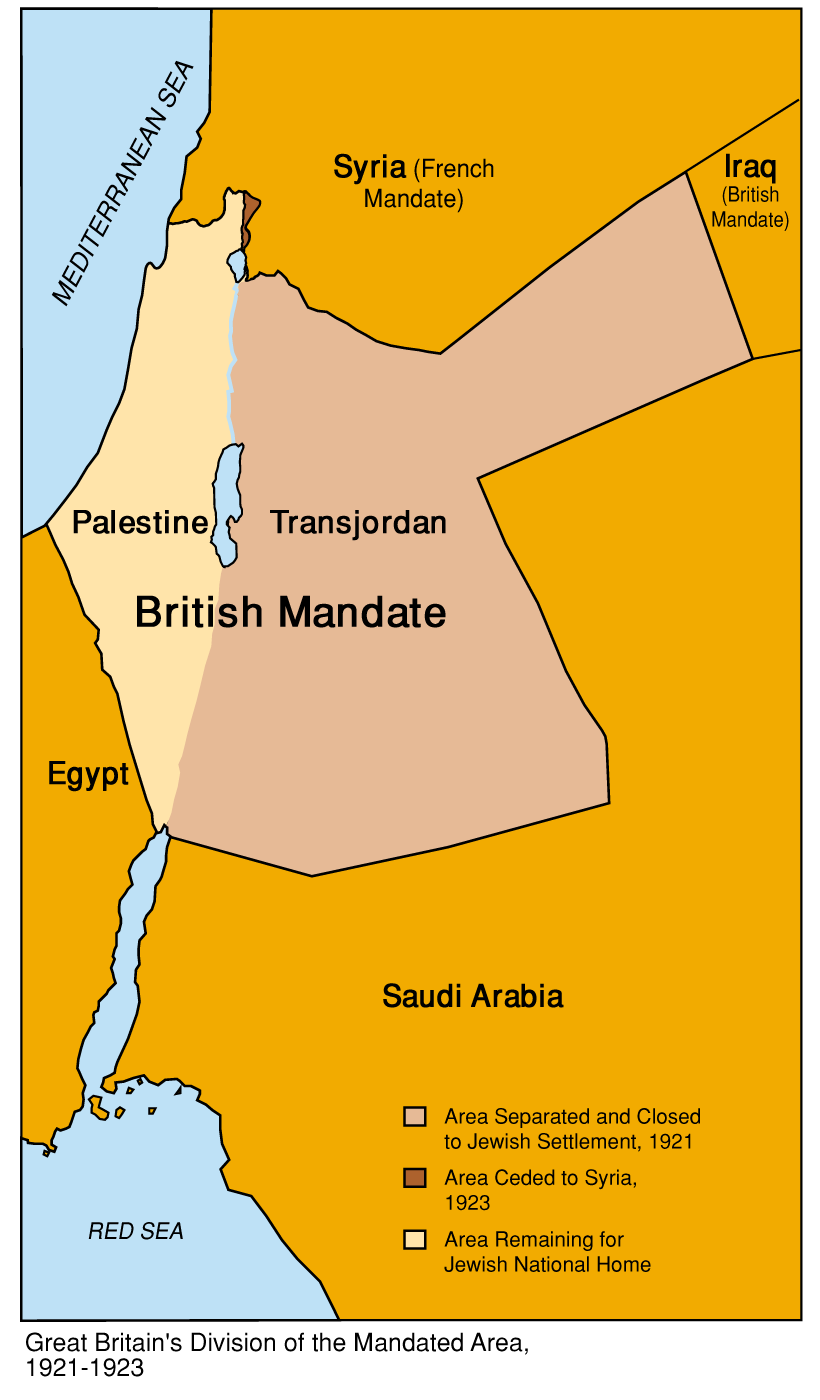Origins of the Name “Palestine”

Map of Palestine
during the monarchy. At that time the area was not yet called Palestine.
Click to enlarge.
The words “Palestine” or “Filastin” do not appear in the Koran. “Palestine” is also not mentioned in the Old or New Testament. It does occur at least eight times in eight verses of the Hebrew concordance of the King James Bible.
Though the definite origins of the word Palestine have been debated for years and are still not known for sure, the name is believed to be derived from the Egyptian and Hebrew word peleshet, which appears in the Tanakh no fewer than 250 times. Roughly translated to mean rolling or migratory, the term was used to describe the inhabitants of the land to the northeast of Egypt – the Philistines. The Philistines were an Aegean people – more closely related to the Greeks and with no connection ethnically, linguistically or historically with Arabia – who conquered the Mediterranean coastal plain that is now Israel and Gaza in the 12th Century BCE.
Prior to the Israelite conquest, the Egyptians called what is now Israel, Syria, and Lebanon Retenu. The term Canaan appeared in the fifteenth century BCE and was subsequently referred to as Eretz Bnei Yisrael,” the “Land of the Children of Israel” (Joshua 11:22) or Eretz Yisrael (I Samuel 13:19) after the Jewish return from Egypt. The name “Israel” was first used in the tenth century BCE to refer to the northern Jewish kingdom following the division of Solomon’s kingdom.
During the Persian period, the area that is now Israel and Syria was referred to as Coele-Syria. A derivative of the name Palestine first appears in Greek literature in the 5th Century BCE when the historian Herodotus used the word “Palaistine” to refer to the coastal strip inhabited by the Philistines.
Judea Gets a New Name
As early as 300 BCE, the term Judaea [Judea] appears, most likely to describe the area where the population was predominantly Jewish. It was distinguished from Palestine and from Syria. Coins with the word Judaea or something similar were produced at the time of the first Jewish revolt (66-70 CE). In the 2nd century CE, the Romans crushed the revolt of Shimon Bar Kokhba (132 CE), during which Jerusalem and Judea were conquered and the area of Judea was renamed Palaestina in an attempt to minimize Jewish identification with the land of Israel.
According to Lewis Feldman, it is likely the appellation was chosen because it was common to use the name of the “nearest and most accessible tribe.” He notes that there is no evidence as to who chose the name or when it was done, but argues it was most likely the Roman Emperor Hadrian who was “responsible for a number of decrees that sought to crush the national and religious spirit of the Jews.”
Nevertheless, Feldman says that Rabbi Akiva testified in the second century that Diaspora Jews referred to the land as Eretz Israel. The rabbis never refer to it as Palestine. He also notes that “even vicious anti-Jewish writers in antiquity generally do not use the term Palestine.
Around the year 390, during the Byzantine period, the imperial province of Syria Palaestina was reorganized into Palaestina Prima, Palaestina Secunda and Palaestina Salutaris. Following the Muslim conquest, place names that were in use by the Byzantine administration generally continued to be used in Arabic and the use of the name “Palestine” became common in Early Modern English. It was used, for example, by the Crusaders in the Middle Ages.
Under the Ottoman Empire (1517-1917), the term Palestine was used as a general term to describe the land south of Syria; it was not an official designation. In fact, many Ottomans and Arabs who lived in Palestine during this period referred to the area as Southern Syria and not as Palestine.
“During the 2,600 years those who lived in what the Roman Emperor Hadrian renamed Palestine were known as Palestinians, including Christians, Jews, Muslims, and people of any ethnic or religious affiliation. Accordingly, Palestinian did not describe any one ethnic or religious group. Its definition applied to anyone living in the territory,” according to Brian Schrauger.
Individually, the Arabs did not call themselves “Palestinians”; most identified as Christians or Muslims, as members of a clan (the two main rivals were the Husseinis and Nashashibis), and as residents of a city such as Jerusalemites.
Leading up to Israel’s independence in 1948, it was common for the international press to label Jews, not Arabs, living in the mandate as Palestinians. According to Zachary Foster, the first Arab to use the term “Palestinian” was Farid Georges Kassab, a Beirut-based Orthodox Christian who “noted in passing” in his 1909 book, Palestine, Hellenism, and Clericalism” that “‘the Orthodox Palestinian Ottomans call themselves Arabs, and are in fact Arabs,’ despite describing the Arabic speakers of Palestine as Palestinians throughout the rest of the book.”
Foster says the term was subsequently used in a few newspaper articles in 1910-1911. He argues that “In June 1913, the concept of a Palestinian identity began forming in the media, prompting Ottoman parliamentarian and Muslim Jerusalemite Ruhi al-Khalidi to write an article titled, “the Palestinian Race,” for the paper Filastin, arguing that Zionists were attempting to create an exclusionary society in Palestine.”
Greater Syria
Six years later, the first “Arab Palestinian Congress” was held in 1919 during which David Margolis noted, the Arabs called for “Palestinian unity and independence, albeit still understanding Palestine as part of ‘Greater Syria.’”
Bernard Lewis noted, “It was with the British conquest of the country in World War I that Palestine for the first time since remote antiquity became a separate entity, this time in a mandate held by the British Empire and approved by the League of Nations. The name adopted to designate this entity was ‘Palestine,’ resuscitated from an almost forgotten antiquity.”
This area included not only present-day Israel but also present-day Jordan. Jews living in the area rejected the name “Palestine” because of its association with what Lewis says was “the largely successful Roman attempt to destroy and obliterate the Jewish identity of the land of Israel. Consequently, Jews typically referred to the land as Eretz Yisrael in Hebrew but would identify as Palestinian Jews in English as reflected by institutions such as the Palestine Post newspaper (later the Jerusalem Post) and the Palestine Symphony Orchestra (later the Israel Philharmonic Orchestra). According to Lewis, Jews agreed to use the word Palestina, transcribed into Hebrew when some designation was needed such as on postage stamps and coins. The abbreviation aleph yod was added to refer to Eretz Yisrael.
Lewis observed that the Arabs saw the name “as a British imperialist device, with Zionist collusion, to slice off a part of the greater Arab homeland.” Muslims did not feel any attachment to “Palestine.” Up to that time, Muslims believed the area should be part of Southern Syria.
That began to change, however, in 1920 when the French deposed King Faisal in Syria. One Palestinian leader, Musa Kazim al-Husayni said, “after the recent events in Damascus, we have to effect a complete change in our plans here. Southern Syria no longer exists. We must defend Palestine.”
 |  |
The Third Palestinian Congress held that year subsequently decided to stop pursuing the idea that Palestine should be part of Syria. “At this moment,” Daniel Pipes noted, “Palestine became acceptable to the Muslims” and established the roots of Palestinian nationalism. This was a previously alien ideology that was imported from Europe.
“Palestinian nationalism originated not in spontaneous feelings but in calculated politics,” Pipes explained. “The Palestine concept served better than that of Greater Syria. It allowed the Arab leaders of Palestine to speak the same political language as the Zionists and the British. Rather than refer to some outside source of authority, they could claim sovereignty for themselves. In the process, they evolved from provincial notables into independent actors. Thus, tactical considerations caused the rapid rise of Palestinian nationalism.”
Still, just a year later, the spokesman for Palestinian Arabs, Haj Amin el-Husseini wrote to Winston Churchill demanding that Palestine be reunited with Syria and Transjordan.
Stirring of Nationalism
As early as 1923, Ze’ev Jabotinsky recognized this nationalistic feeling, though he saw it more as a reaction to Zionism, which it was. “They feel at least the same instinctive jealous love of Palestine, as the old Aztecs felt for ancient Mexico, and the Sioux for their rolling Prairies,” he wrote in The Iron Wall. “It may be that some individual Arabs take bribes. But that does not mean that the Arab people of Palestine as a whole will sell that fervent patriotism that they guard so jealously….Every native population in the world resists colonists as long as it has the slightest hope of being able to rid itself of the danger of being colonized. That is what the Arabs in Palestine are doing, and what they will persist in doing as long as there remains a solitary spark of hope that they will be able to prevent the transformation of “Palestine” into the “Land of Israel.”
The Mufti of Jerusalem, Haj Amin Husseini, became the leader of the Palestinian national movement, though his beliefs were rooted more in Islam than politics and his goal to expel the Zionists and British from the area established by the mandate. In 1937, he testified before the Peel Commission and had the following exchange with Lord Peel:
Q: Lord Peel: Since you demand the establishment of a national government in Palestine, what will you do with the 400,000 Jews already living there?
A: Mufti: It will not be the first time that Jews have lived under the aegis of an Arab state. In the past it has been the Arab states which were the more compassionate to them. History shows that, during all periods, the Jews only found rest under the protection of Arab rulers. The East was always a shelter for Jews escaping from European pressure.
Pipes relates that the mufti stood before the Palestine National Council in Gaza and declared the existence of an All-Palestine Government on October 1, 1948:
In theory, this state already ruled Gaza and would soon control all of Palestine. Accordingly, it was born with a full complement of ministers to lofty proclamations of Palestine’s free, democratic, and sovereign nature. But the whole thing was a sham. Gaza was run by the Egyptian government, the ministers had nothing to oversee, and the All-Palestine Government never expanded anywhere. Instead, this façade quickly withered away.
When Israel was reconstituted as a nation-state in May 1948, the Jews began to identify as Israelis and referred to Muslims (and the smaller number of Christians) who became citizens as Israeli Arabs. Over the decades, some Arabs increasingly came to identify themselves as Israelis, and learned Hebrew, but most remained committed to the Palestinian nationalist cause, though few expressed any desire to leave Israel for a Palestinian state.
Following the 1948 War, historian Benny Morris notes, Palestine Arabs were not yet called “Palestinians.” Furthermore, the Arab powers had no interest in creating a Palestinian entity. Instead, the Syrians, Egyptians and Jordanians seized control of the areas they occupied. Lewis argues the idea of developing a “distinctive Arab national entity” – “Palestine” – in the area occupied by Jordan did not occur until Israel captured the areas in 1967 and Jordan withdrew its claims and ceded representation of the Palestinians to the PLO.
Feldman concludes:
Sources:The Histories of Herodotus.
Online Judaic Studies (David Jacobson).
Palestine Facts.
Wikipedia.
Blue Letter Bible.
Louis H. Feldman, “Some Observations on the Name of Palestine,” Hebrew Union College Annual, 1990, Vol. 61, (1990), pp. 1-23.
David Margolis, “Who Are The Palestinians?” My Jewish Learning, accessed May 15, 2020.
Jon Kimche, There Could Have Been Peace: The Untold Story of Why We Failed with Palestine and Again with Israel, (England: Dial Press, 1973), p. 211.
Zachary J. Foster, “What’s a Palestinian?” Foreign Affairs, (March 12, 2015).
Brian Schrauger, “Whose land is it?” Jerusalem Report, (March 23, 2020).
Bernard Lewis with Buntzie Ellis Churchill, Notes on a Century: Reflections of a Middle East Historian, (NY: Penguin Books, 2012).
Daniel Pipes, “The Year the Arabs Discovered Palestine,” Middle East Review, (Summer 1989).
Daniel Pipes, “The Year the Arabs Discovered Palestine,” Jerusalem Post (September 13, 2000).
Benny Morris, “Military Might and Demographic Destiny,” Sapir, (Summer 2021).
Maps: Palestine During the Monarchy - G. Woolworth Colton, CartographerPalestine During the Monarchy. [New York: G. W and C. B. Colton & Co., ?, 1895], Library of Congress.
Levant Under Ottoman Rule - Institute for Curriculum Services.
Maps of Palestine - Israeli Ministry of Foreign Affairs



